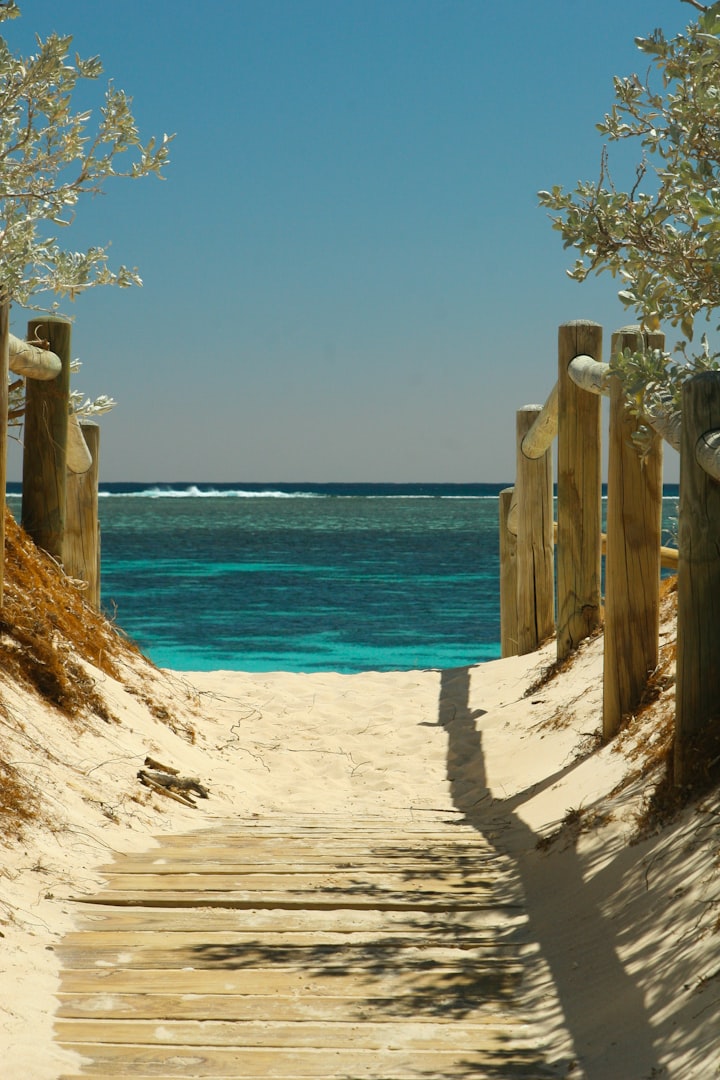California Coastal Access Law
Don't let people tell you the beach is private

California Coastal Access Law
History of Coastal Access in California.
The current rules in California are such that with the exception of a few military bases and natural geographical barriers, a person should be able to walk up and down the California Coast line, on west sand, completely unmolested. If the tide rose to its high mark the individual would have to wade or swim until the tide subsided. This is because in California, people have the right to access the coastlines for the purpose of recreation.
The Precedent for this is set up in several places in the law, the first being the United States public trust doctrine.
“In 1892, the United States Supreme Court decided Illinois Central Railroad v. Illinois, which remains the principle authority on the public trust doctrine in the United According to the Court, title to tide waters and the land below the high water mark is held in trust for the people of the state so that the people can navigate the waters, conduct commerce over them, and fish in them free from obstruction and interference by private parties.”
This applies to over a thousand miles of public coastline, not including islands and large bays. Later the California Supreme Court ruled in National Audubon Society v. Superior Court set a precedent for public trust in California being applied to recreation and aesthetic interest, not just fishing and navigation. Furthermore the California Constitution in Article X, Section 4, maintains that private entities cannot restrict the navigability of waterways in the state.
In 1972 coastal activists frustrated with the legislatures lack of planning on the California coastline, passed Proposition 20 to set up six region commissions, and one statewide commission to plan the development of the California coasts. The commissions were only supposed to last until 1976. In 1976 the California Coastal Act was passed by the legislature with the intent to make these commissions permanent and ensure access to quality recreational beaches in California.
Now most of the regulation and planning for recreational beach access happens at the local level partnered with the California Coastal Commission, tasked with ensuring fair access to beaches in the state. The commission grants permits for development, monitors the use of access ways, keeps a catalogue of unaccepted offers to dedicate, and published a guide on how to access the coast available to the people.
The primary tool the Commission has to guarantee access to beach sites is that the Commission must issue permits for development on the coast. If the commission deems that the development will decrease the public’s access to a certain area, or the access in the area is already restricted and needs improving, the commission will prefer developments were the developer submits an OTD, or offer to dedicate. These OTDs can be vertical, running from the high way to the beach, or lateral, going up from the high water mark a certain distance and along the beach. OTDs are active for 21 years after they are first recorded and are not easements. They are merely offers until such time that some institution accepts ownership of them. Once an OTD is accepted it becomes part of the public domain, while a government or nonprofit becomes responsible for maintaining the access point and protecting the private property rights of the developer.
There are flaws in this process however where it takes large amounts of time before these access ways are accepted and begin functioning, some being at risk of not being accepted or developed at all, causing them to expire.
“The acceptance of OTDs is critical to ensuring public and equal access to the beach. As of July 2004, 79% of lateral OTDs have been accepted, 20% remain outstanding offers, and less than 1% have expired. For vertical OTDs, 71% have been accepted, 27% remain outstanding, and 2% have expired. In 2002, California passed legislation that declares the state’s intent to accept OTDs that are about to expire in order to prevent permanent loss of public accessways. Under that legislation, the California Coastal Conservancy must accept all public access OTDs that are within 90 days of their expiration, and must open at least three accessways every year.”
This highlights how slow the process of accepting these offers have been. With two percent of vertical OTDs already having expired in. The States 2002 legislative decision strengthens the Coastal Commission powers to protect public access quite a bit as now OTDs are more of an eventuality, rather there being a small chance that after 21 years no easement will have been created.
Another way for the commission to create easements on property to create beach access is the investigation of public prescriptive rights. Essentially if it is determined the public is using that private property without permission from the owner historically, the commission could claim the public had prescriptive rights over that area. If research indicates that is a possibility the California Attorney Generals Office has the authority to take the legal action necessary to protect those areas.
In 1987 the United States Supreme Court in Nollan v. California Coastal Commission drastically reduced the Commissions ability to seek OTDs, claiming that the commission needed to prove a more “essential nexus” between the proposed development, and a reduction in the ability to access the coast.
In 2015 new authority was granted to the California Coastal Commission to assess fines to anyone who attempts to block a public access point, or to obscure it in some way. Under the new rule passed by the legislature offenders now have thirty days to comply, or be fined; unlike the previous model of enforcement, where litigation could be dragged out for years, while the beaches remained closed.
Primary Areas of Controversy
Regardless of all these statutes there is a reality where in certain California areas public access isn’t easy, and is actively restricted by local homeowners. It is commonly recognized, and even acknowledged by former Commission Chairwoman Sara Wan that Malibu is the worst spot in California as far as access goes. One reason for this issue was the way Malibu ended up being developed, most of the development happening before the commission was created in 1972. The high desirability of real estate on the waterfront caused massive building that restricts access. There is also a culture of evading the law in Malibu and other California beach communities. The phenomenon of posting phony signs, hiring security guards to harass people, and deliberately not posting signs leading people to the beach has all been recorded. The new ability of the State to levy fines against this kind of behavior has drastically improved conditions on the ground, but they culture of these communities is still very anti-access. Mike Davis in his essay “The Case for Letting Malibu Burn” describes having locals equate these access points to “freedom of movement for arsonists.” A strange concern considering that Malibu exists in the path of natural wild fires, while evidence of arson is only speculated about.
The other primary source of controversy is the States methods of gaining OTDs and easements over private land. Justice Scalia famously calling it an “Out-and-out plan of extortion.” Regardless the public right to the water is very legally secure, it is just the right of public access points that are being legally argued over.
Other States
Few States have the volume of coastline that California does, the federal governments acknowledgement of the public rights to navigate the coast do put most states on similar footing.
California’s rival in terms of Ocean exposure Florida however just passed a law making it more difficult for local governments to control public access points along the beach, and to allow use of dry sand even when there is a historical precedent of public use. Regarded as a win for beachfront property owners, this is a much different approach than current Californian Policy.
Branches of Government Involved in this Issue
As it is established earlier in the paper the U.S. Supreme Court, the California Constitution, and the California Supreme Court have established the right of Californians to access and enjoy their coastal areas.
Then it was the people of California that passed Proposition 20 adding an element to the California Government to plan for and protect the ability of Californians to use the Coast recreationally. The measure passed with 55% of the vote. The State legislature then decided to keep the Coastal Commission permanently. The office of the Governor and the State Senate are responsible for putting people on the commission as well.
The US Supreme Court in the Nolan Case then limited the powers of the Commission.
Lastly the Commission must work with local authorizes to accept OTDs and turn them into easements, that local governments, or other groups must then maintain.
Interest Groups
Non-profits have the ability to take up OTDs and maintain them for the Coastal Commission and there are a few that do so. Such as Access for All which has a number of OTD’s in Malibu. The principal interest group in this is the Surfrider Foundation, a national organization committed to beach access. They primarily serve as a watchdog for violations of the law by private landowners and often take part in litigation against these violators.
Hyperpluralism
This issue is the epitome of Hyperpluralism; it is a California battle through and through. A battle that started by California taking a liberal understanding of US Supreme Court Doctrine, and solidifying that by initiative in the 70s. Where it has since been weighed in on by every level of government imaginable, as passionate surfers get politically active about beach access, and the super rich of the California beach cities try to circumvent the law. Yes, it fits the confines of Hyperpluralism in California very well. It could be argued that one side, the Coastal Commission is two powerful and two functional for this to be true Hyperpluralism, however, the large amount of litigation and the inability for the Commission to rapidly make changes on the ground does to me indicate an amount of gridlock characteristic of Hyperpluralism.
Viewpoints and Diversity
One Viewpoint is of the Californians that likely don’t live on the coast. “In a 2016 Field poll, 90 percent of California voters said the coast is personally important to them, nearly 75 percent say they visit the coast at least once per year, and 62 percent said that lack of adequate access to the coast is still a problem.” The idea put forward by Prop 20 that since Californians have a right to use the coast for pleasure, they need to have practical access to it as well. That battle however has already been one, and is only being fleshed out in certain areas along the coast. The large issue at stake now for those who want to see everyone have access to the beach is that many of the beneficiaries of this fight have been the white middle classes of California. People of color and low incomes communities still lack adequate access to these public areas. Due to lacking financial ability, well maintained beaches in their area, or a lack of public transportation to the beach. The next fight will should be for diverse public use of the beach.
The opposing viewpoint is of the property owners on the beach, who don’t want people walking; abound on their property, or sliding between their houses to get to the beach. They also certainly don’t want to sacrifice a few feet of their precious beach property to an OTD every time they want to develop on their land. There is also the issue of prescriptive rights, where because people have been trespassing for many years, they can continue to do it with legal protections. It could all be seen as a bit frustrating. That is why Billionaire Vinod Khosla has taken a dispute over the access path to Martins Beach on his property to the Supreme Court, or is at least attempting to after losing several lower court fights.
My Thoughts
I’ve always used beaches run by the state or a city, I’ve never really used beaches that back up to residences, but I’d hate to think of someone preventing me from doing so. The Coastline is a highly desirable location, and it is very limited. I don’t mind that people with wealth would want to live near it, but I do resent the idea that they would restrict access to it. I think that there should be a well-maintained access point every mile. I also think that those who want to live on the ocean should pay for it. It is not unreasonable for us to tax so scarce a resource as beachfront property. In fact so rare is and desirable is California beachfront property that it would likely not hurt the demand for these houses at all. I also think we should do more to guarantee the public ownership of lots of dry sand above the tide line as well. I understand that people have a right to personal property, but this is a scarce natural environment. One that the state should be a steward of.
1"Article X, California Constitution - Ballotpedia". 2018. Ballotpedia.Org.
2 Ibid. Page 25
3 Ibid. Page 25
4 "Article X, California Constitution - Ballotpedia". 2018. Ballotpedia.Org.
5 “California Proposition 20, Creation of the California Coastal Commission 1972 – Ballotpedia”. 2018. Ballotpedia.Org
6 Ibid. Center for Law in the Public Interest. Page 26
7 “Our Mission – California Coastal Commission” 2018.
8 Ibid. Center for Law in the Public Interest. Page 26
9 Ibid.
10 Ibid. Page 27
11 “Some Facts About Public Prescriptive Rights”. California Coastal Commission. 2018. https://www.coastal.ca.gov/access/pr-access-facts.pdf
12 Ronald A. Davidson and J. Nicholas Entrikin, “The Los Angeles Coast as a Public Place”, Geographical Review, Vol. 95, No. 4 (October, 2005), pp. 586-587
13 Atkins, Toni. 2018. "Public’S Right To Beach Access Gets State Support". Sandiegouniontribune.Com.
14 Ibid. Davidson and Entrikin. Page 587.
15 Ibid.
16 Ibid. Center for Law in the Public Interest. Page 26-28
17 Mike Davis, “The Case for Letting Malibu Burn” Southern California Institute of Architecture, Page 25
18 Ibid.
19 Ibid. Davidson and Entrikin. Page 588.
20 "Public Access To Florida Beaches Will Be Harder For Local Governments To Guarantee Under New Law". 2018. Tampabay.Com.
21 Ibid. Ballotpedia.com Prop 20
22 Ibid. Davidson and Entrikin. Page 587.
23 "Beach Access". 2018. Surfrider Foundation.
24 “The Past Present and Future of California’s Coastal Act” UC Berkeley. 2016. Page 9.
25 Ibid. Page 9.
26 Ibid. Page 9-10
27 LA Times Editorial Board. 2018. "Cutting Off The Public's Beach Access To Appease A Billionaire Would Be Unconscionable". Latimes.Com.





Comments
There are no comments for this story
Be the first to respond and start the conversation.